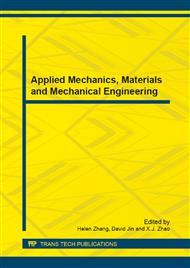[1]
T.W. Chou and F.K. Ko, Textile Structural Composites, Elsevier Science Publishers, Amsterdam, (1989).
Google Scholar
[2]
D.W. Whyte, Ph.D. thesis, Drexel University, Philadelphia, PA, (1986).
Google Scholar
[3]
C.L. Ma, J.M. Yang, T.W. Chou, Elastic stiffness of three-dimensional braided textile structural composites, Composite Materials: Testing and Design, Seventh Conference. 404-421, (1984).
DOI: 10.1520/stp35360s
Google Scholar
[4]
J.M. Yang, C.L. Ma, T.W. Chou, Fiber inclination model of three-dimensional textile structural composites, Journal of Composite Materials 20, 472-483, (1986).
DOI: 10.1177/002199838602000505
Google Scholar
[5]
J.H. Byun, G.W. Du, T.W. Chou, Analysis and modeling of three dimensional textile structural composites, High-Tech Fibrous Materials 3, 22-33, (1991).
DOI: 10.1021/bk-1991-0457.ch002
Google Scholar
[6]
Z.G. Huang, A braiding model prediction of the ultimate strength of composite laminates subject to biaxial loads, Composites Science and Technology 64, 395-448, (2004).
DOI: 10.1016/s0266-3538(03)00220-3
Google Scholar
[7]
D.S. Li, Z.X. Lu, W.S. Lu, Theoretical prediction of stiffness and strength of three-dimensional and four-directional braided composites, Applied Mathematics and Mechanics 29, 163-170, (2008).
DOI: 10.1007/s10483-008-0204-1
Google Scholar
[8]
Y.Q. Wang, A.S. D Wang, Microstructure/property relationships in three- dimensionally braided fiber composites, Composites Science and Technology 53, 213-222, (1995).
DOI: 10.1016/0266-3538(95)00021-6
Google Scholar
[9]
J.D. Whitcomb, K. Woo, Macro finite element for analysis of textile composites, Journal of Composite Materials 28, 607–618, (1994).
DOI: 10.1177/002199839402800702
Google Scholar
[10]
X.G. Yu, J.Z. Cui, The prediction on mechanical properties of 4-step braided composites via two-scale method, Composites Science and Technology 67, 471-480, (2007).
DOI: 10.1016/j.compscitech.2006.08.028
Google Scholar
[11]
S.R. Kalidindi and E. Franco. Numerical evaluation of isostrain and weighted- average models for elastic moduli of three-dimensional composites. Composites Science and Technology 57, 293-305, (1997).
DOI: 10.1016/s0266-3538(96)00119-4
Google Scholar
[12]
T. Zeng, L.Z. Wu, L.C. Guo. A finite element model for failure analysis of 3D braided composites. Mater Sci Eng A 366, 144-51, (2004).
Google Scholar
[13]
T. Zeng, D.N. Fang, L. Ma, L.C. Guo. Predicting the nonlinear response and failure of 3D braided composites. Mater Lett 58, 3237-41, (2004).
DOI: 10.1016/j.matlet.2004.05.057
Google Scholar
[14]
L.L. Jiang, T. Zeng, S. Yan, D.N. Fang, and Y. Guo. Predicting mechanical properties of 3D braided composites using a helix geometry model. Polym Polym Compos 19, 397-400, (2011).
DOI: 10.1177/0967391111019004-522
Google Scholar
[15]
B. J. Pang, Ph.D. thesis, Harbin Institute of Technology, (1997).
Google Scholar
[16]
S.R. Kalidindi and A. Abusafieh. Longitudinal and Transverse Moduli and Strengths of 3D Braided Textile Composites with Low Braid Angles. Journal of Composite Materials 30, 885-905, (1996).
DOI: 10.1177/002199839603000802
Google Scholar


